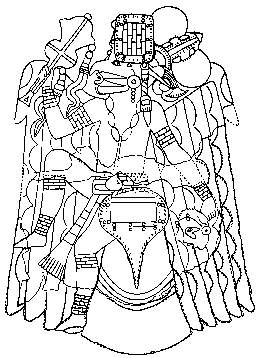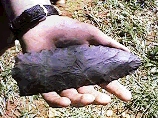Mississippian and Yayoi-Kofun Civilizations
Preface
We went to the Etowah Indian Mounds in northern Georgia with high
expectations that we would find many similarities between the Yayoi Kofun period in Japan
and the Mississippian Civilization in America. Both civilizations stemmed from related
eastward migrations from the Asian continent; each developed agriculture and extensive
trade routes along river and sea systems (Mississippi
system and Sea of Japan system); and, both civilizations constructed burial mounds
along these river systems for their chiefs and priests. Closer observations at the Etowah
Indian Mound site, however, revealed many differences.The following collection of our
impressions reveal some of these differences. These impressions should only be taken as a
beginning for more serious inquiry.
Big Differences
 At the
Etowah Mounds site there are three mounds: A, B, and C. At most Yayoi Kofun (mounds) only
one priest/king is entombed, but at the Etowah Mounds at the biggest mound (A) there was
no grave, but only a public place for special events. The smaller mound B was where the
living chief resided.
At the
Etowah Mounds site there are three mounds: A, B, and C. At most Yayoi Kofun (mounds) only
one priest/king is entombed, but at the Etowah Mounds at the biggest mound (A) there was
no grave, but only a public place for special events. The smaller mound B was where the
living chief resided.
Mound C was the tomb of the priests/chiefs of many generations.
Symbols
 Inscribed in the circle of an Etowah Indian design are various symbols, for
example: birds (eagles and woodpeckers), snakes, and deer. They are very beautiful
designs. Birds are probably the most noticeable. The most famous is the Eagle Dancer. The
dancers' nose and face is stylized to look like an eagles'. The design is mysterious.
Occasionally, dancers were represented wearing feathers and deer antlers. In Yayoi-Kofun
civilization we did not see any such obvious symbols represented.
Inscribed in the circle of an Etowah Indian design are various symbols, for
example: birds (eagles and woodpeckers), snakes, and deer. They are very beautiful
designs. Birds are probably the most noticeable. The most famous is the Eagle Dancer. The
dancers' nose and face is stylized to look like an eagles'. The design is mysterious.
Occasionally, dancers were represented wearing feathers and deer antlers. In Yayoi-Kofun
civilization we did not see any such obvious symbols represented.
Technology

 During the
Jomon-Yayoi periods arrowheads made from obsidian and flint can be found. The same is true
for the Etowah site and its preceding periods. The pattern of development at this level is
remarkably similar. Differences appear in the realm of metallurgy. It appears that the
Mississippian cultures used metal (copper) for more decorative purposes than the Yayoi,
who had begun using metal (steel) for agriculture and war by this time. Although
they are both metals, however, copper and steel however should not be compared however.
During the
Jomon-Yayoi periods arrowheads made from obsidian and flint can be found. The same is true
for the Etowah site and its preceding periods. The pattern of development at this level is
remarkably similar. Differences appear in the realm of metallurgy. It appears that the
Mississippian cultures used metal (copper) for more decorative purposes than the Yayoi,
who had begun using metal (steel) for agriculture and war by this time. Although
they are both metals, however, copper and steel however should not be compared however.

Adventurers' main page
 At the
Etowah Mounds site there are three mounds: A, B, and C. At most Yayoi Kofun (mounds) only
one priest/king is entombed, but at the Etowah Mounds at the biggest mound (A) there was
no grave, but only a public place for special events. The smaller mound B was where the
living chief resided.
At the
Etowah Mounds site there are three mounds: A, B, and C. At most Yayoi Kofun (mounds) only
one priest/king is entombed, but at the Etowah Mounds at the biggest mound (A) there was
no grave, but only a public place for special events. The smaller mound B was where the
living chief resided. Inscribed in the circle of an Etowah Indian design are various symbols, for
example: birds (eagles and woodpeckers), snakes, and deer. They are very beautiful
designs. Birds are probably the most noticeable. The most famous is the Eagle Dancer. The
dancers' nose and face is stylized to look like an eagles'. The design is mysterious.
Occasionally, dancers were represented wearing feathers and deer antlers. In Yayoi-Kofun
civilization we did not see any such obvious symbols represented.
Inscribed in the circle of an Etowah Indian design are various symbols, for
example: birds (eagles and woodpeckers), snakes, and deer. They are very beautiful
designs. Birds are probably the most noticeable. The most famous is the Eagle Dancer. The
dancers' nose and face is stylized to look like an eagles'. The design is mysterious.
Occasionally, dancers were represented wearing feathers and deer antlers. In Yayoi-Kofun
civilization we did not see any such obvious symbols represented. 
 During the
Jomon-Yayoi periods arrowheads made from obsidian and flint can be found. The same is true
for the Etowah site and its preceding periods. The pattern of development at this level is
remarkably similar. Differences appear in the realm of metallurgy. It appears that the
Mississippian cultures used metal (copper) for more decorative purposes than the Yayoi,
who had begun using metal (steel) for agriculture and war by this time. Although
they are both metals, however, copper and steel however should not be compared however.
During the
Jomon-Yayoi periods arrowheads made from obsidian and flint can be found. The same is true
for the Etowah site and its preceding periods. The pattern of development at this level is
remarkably similar. Differences appear in the realm of metallurgy. It appears that the
Mississippian cultures used metal (copper) for more decorative purposes than the Yayoi,
who had begun using metal (steel) for agriculture and war by this time. Although
they are both metals, however, copper and steel however should not be compared however.